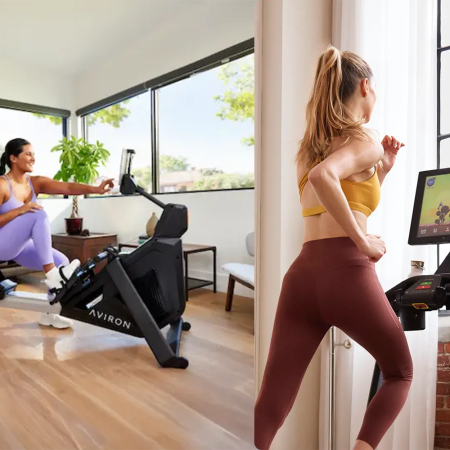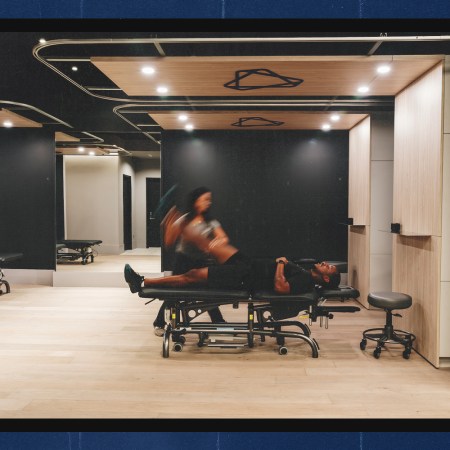Hot yoga. Cold HIIT. VR gaming gyms.
These days, you can’t jog down the block without passing a new workout “concept.”
But the real future of fitness — as evidenced by myriad exercise apps, on-demand classes and top-of-the-line equipment — isn’t in a gym. It’s in your home.
To get the lowdown on the future of home fitness, we recently visited Eric Villency, the designer behind SoulCycle, Peloton and now his very own next-gen stationary bike.
His first thoughts on our collective cardiovascular future?
“One of the big things everyone keeps saying is, ‘Can I stream Netflix on the monitor?’”
He’s talking about the screen on the new VDG Fitness Bike, the first proprietary stationary bike from Villency Design Group. And while that comment may sounds frivolous, it’s emblematic of what people want from their exercise equipment: customization. People don’t want to stick to someone else’s schedule, they want to work out when they want (before work, after work, during lunch), for however long they can (see: unlimited seven-minute workout apps) while multitasking, if possible (how else are you supposed to watch everything Netflix churns out?).
The VDG bike solves this, and many of the other qualms Villency and his team have with indoor bikes — even the ones he’s famous for.
“The chance of us saying, ‘Hey let’s do something exactly the way we think it should be,’ was really fun for everyone on the team,” he says. “We had so much experience with it, and we thought it could be improved.”
So how do you improve on SoulCycle and Peloton, two studios that top the list of cult-like following not just for cycling, but for all of fitness-dom?
First off, the VDG Bike features both a Bluetooth-enabled screen for streaming whatever content you like (Villency even recommends classes from competitors), which includes metrics calculated by sensors embedded throughout the bike. Those stats are also available on a sleek iOS app. For the frame, Villency turned not to either of his previous designs, but to outdoor bikes.
“For us, outdoor bikes are the holy grail, we’re always looking at them. Even if we’re not working on a fitness project, they’re just like these gorgeous carbon fiber, amazing things, and we always try to think: How do we bring that outdoor indoor?” he says. “So we did a split frame, which is unique. Most companies wouldn’t spend the amount of money to create this tooling, but we thought it was a really strong visual queue, so we did it.”
The living room-sanctioned frame is made of carbon steel and weighs in at 340-lbs. (around three times his original SoulCycle prototype, he says). Other features include ergonomic accessory holders for water bottles, meticulously-calibrated magnetic resistance and a sweat-guard design that’ll keep your inevitable perspiration from penetrating said magnetic resistance.
The bike will be sold through VDG starting after Thanksgiving for around $1,900, and is available for individual use as well as for cycling studios. And while their own streaming content won’t be available until spring of 2019, Villency reiterates, “People are using it with other people’s apps … which is something we don’t mind at all.”
Some Other Home Fitness Takeaways from Villency …
Home fitness is going the way of the music industry
“We believe really strongly — and there are a lot of companies that raise a lot of money that don’t agree — that you want to empower the consumer, and you should uncouple hardware and software. To us, it’s similar to music. In the beginning, music companies were like, ‘We don’t want you to download.’ Well, it was gonna happen anyway. Now as a consumer, it’s like, ‘I love riding my bike, but tomorrow I want to do yoga, or I might want to get on the rower.’ So we wanted to create a platform that was agnostic to all of it. If you want to use metrics, if you want to use streaming content, great. If you don’t, this can do anything. That was part of it, and then developing an app ecosystem for people that do want content.”
Bet on good content and top-of-the-line equipment, not exclusivity
“You’re seeing that people are developing their own apps that they can use and subscribe to without having equipment. I think in the next few years, particularly, you’re going to see things like VR coming. We’re already playing with it. Looking at a screen could be really dated in a few years. But people also like good equipment. They don’t want it to break, they want it to have good ergonomics, kinesiology should be solid. But I think if you say you must use this content with this [equipment], I think that’s a big bet and it remains to be seen if people wanna be dictated to. My sense, with how the world is going, is that people want choice.”
The main problem with home fitness gear up til now
“What we’re also doing more of, which is important to us, is having a wellness-based philosophy, or point of view on our new equipment. We’ve always created equipment, but [recently] we’ve been trying to partner with PTs and doctors to get some guidance on: how is this going to help people feel better, not just workout? I think that’s been ignored a lot, and how equipment’s been developed a lot, for indoors. So we’re doing a lot of things which do have medical expertise, and we have something coming out pretty quick.”
Four Other Pieces of Home Fitness Equipment We Love …
Photo courtesy of NordicTrack
Fusion CST Series by NordicTrack
A best-in-class full-body workout machine that’s as handsome as it is Herculean. Look, let’s just get it out there: we all associate NordicTrack with late-night infomercials. But after testing out their new slate of equipment, we’re happy to report they’ve officially moved into the 21st century (frankly, the Fusion CST feels straight out of the 22nd century). Integrated with classes on a 22-inch screen via iFit and auto-adjusting resistance via a mesmerizing magnetic wheel, this machine will kick your butt and look good doing it. We also like their new RW900 Rower, which can also give a full-body burn, but shines when streaming iFit classes like the one taught by two-time Olympic gold-medalist Susan Francia.
Photo courtesy of Mirror
Mirror
A high-def display that beams a slew of interactive workout classes into your home while monitoring your daily progress. On its own, the device looks like a your standard full-length mirror. As far as workout equipment goes, it already wins on looks and unobtrusiveness.
Photo via Tonal
Tonal
Sort of a combination of Mirror and Fusion CST, it hangs on your wall (integrating relatively seamlessly with the decor in its chosen room) but has arms that can be unleashed for a workout. Similar to the other pieces mentioned here, an electromagnetic drive is used for weight resistance rather than clunky plates. Also, personal trainers walk you through workouts in the digital display, including an introductory session to assess how much you should be lifting. (Currently only available in the S.F. Bay Area. Shipping nationwide in the coming months.)
Main photo courtesy of Villency Design Group
The Charge will help you move better, think clearer and stay in the game longer. Subscribe to our wellness newsletter today.























